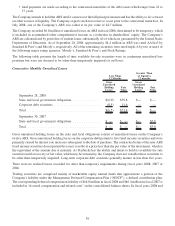Starbucks 2008 Annual Report Download - page 71
Download and view the complete annual report
Please find page 71 of the 2008 Starbucks annual report below. You can navigate through the pages in the report by either clicking on the pages listed below, or by using the keyword search tool below to find specific information within the annual report.
The components of accumulated other comprehensive income, net of tax, were as follows (in millions):
Fiscal Year Ended Sep 28, 2008 Sep 30, 2007
Net unrealized losses on available-for-sale securities ................ $ (4.1) $ —
Net unrealized losses on hedging instruments...................... (22.2) (27.1)
Translation adjustment . . . ................................... 74.7 81.7
Accumulated other comprehensive income ........................ $48.4 $ 54.6
As of September 28, 2008, the translation adjustment of $74.7 million was net of tax provisions of $7.0 million. As
of September 30, 2007, the translation adjustment of $81.7 million was net of tax provisions of $7.3 million.
Note 14: Employee Stock and Benefit Plans
The Company maintains several equity incentive plans under which it may grant non-qualified stock options,
incentive stock options, restricted stock, RSUs, or stock appreciation rights to employees, non-employee directors
and consultants. The Company issues new shares of common stock upon exercise of stock options and the vesting of
RSUs. As of September 28, 2008, there were 51.1 million shares of common stock available for issuance pursuant to
future equity-based compensation awards.
The Company also has employee stock purchase plans (“ESPP”).
The following represents total stock based compensation and ESPP expense recognized in the consolidated
financial statements (in millions):
Fiscal Year Ended Sep 28, 2008 Sep 30, 2007 Oct 1, 2006
Stock option expense ............................ $57.6 $ 92.3 $ 94.8
RSU expense.................................. 5.6 — —
ESPP expense ................................. 11.8 11.6 10.2
Total stock-based compensation expense on the consolidated
statements of earnings ........................... $75.0 $103.9 $105.0
Total related tax benefit............................ $24.0 $ 35.3 $ 36.1
Stock-based compensation capitalized in the respective
fiscal year, as included in “Property, plant and equipment,
net” and “Inventories” on the consolidated balance
sheets ....................................... $ 1.9 $ 2.5 $ 2.1
The decrease in stock option expense in fiscal 2008 was due to a higher level of forfeitures.
Stock Option Plans
Stock options to purchase the Company’s common stock are granted at the fair market value of the stock on the date
of grant. The majority of options become exercisable in four equal installments beginning a year from the date of
grant and generally expire 10 years from the date of grant. Certain options granted prior to October 1, 2006 become
exercisable in three equal installments beginning a year from the date of grant. Options granted to non-employee
directors generally vest over one to three years. Nearly all outstanding stock options are non-qualified stock options.
The fair value of each stock option granted is estimated on the grant date using the Black-Scholes-Merton (“BSM”)
option valuation model. The assumptions used to calculate the fair value of options granted are evaluated and
revised, as necessary, to reflect market conditions and the Company’s experience. Options granted are valued using
the multiple option valuation approach, and the resulting expense is recognized using the graded, or accelerated,
attribution method, consistent with the multiple option valuation approach. Compensation expense is recognized
only for those options expected to vest, with forfeitures estimated at the date of grant based on the Company’s
historical experience and future expectations. Prior to the adoption of SFAS 123R on October 3, 2005, the effect of
forfeitures on the disclosed pro forma expense amounts was recognized as the forfeitures occurred.
65
























